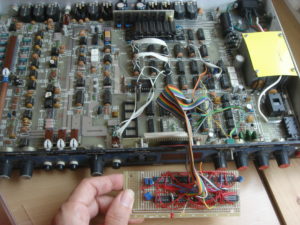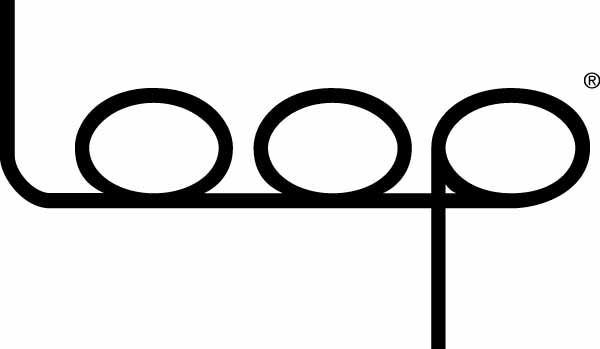How the Gibson / Oberheim Echoplex Came Together
by Matthias Grob, 1998
| In 1985, after I got sick of rock bands, I started to play my rather introspective music, using the Roland SDE 3000, then t.c. 2290. But, like many of you, I was not satisfied. (strange enough, I never saw an original Echoplex up to today!) At first because the delay would repeat any sound before I tapped my correct time. But then, I mainly needed to extend the loops not only horizontally – layering more and more voices – but “vertically” – multiplying the delay time precisely: Music usually has the characteristics of being built on short repeated rhythm patterns, that are the base of a longer harmonic turn around that are repeated to form each part that together end up in a song.I wanted to build the music like anyone does it on a drum machine, but with real sound in real time, so I did not have to record a basic beat for 20 seconds in front of the public before starting to put harmonies on top of it. Tapping is not accurate enough for multiples, because it usually leaves the bases irregular and creates clicks in the smooth carpets I often create for a base. I used to calculate a multiple of the delay time displayed on the 2290 while playing and then typed the value into the keypad – scary to remember!I went to Denmark and proposed to t.c. to add such functions for looping to the 2290. They thought there would be no market. I wrote to Roland, but they claimed to do this all and have patents – did not understand that! Then I was looking for Lexicon and was lucky to meet Gary Hall. He understood quickly what I wanted, but found that Lexicon would not invest into such a machine (about 4 years before the JamMan). But he sold me his (!) PCM 42 and advised me how to implement 30 sec and I squeezed a board with a bunch of TTL chips into it and achieved tap and multiply functions!
Still, the functions were not perfect and I wanted digital feedback to keep the loops without deteriorating and still be able to fade them any time. Also I was sick of destroying nice loops with a wrong note or noise. It is necessary sometimes to jump back and undo what you do not like. So in ’91 I decided to build the machine in my small laboratory at PARADIS in Switzerland, and immediately, fate sent me Eric, a genius programmer. He had come to live in our community when I realised he had just finished his studies. Since he was experienced in 68000 systems and DSPs were still expensive in Switzerland, we started our crazy project on a 68000 with a development system that was badly adapted to our mac IIcx. And we ended up creating 10,000 lines in assembler! I did the engineering of the hardware and matched the cheapest 350 different parts to a manufacturable unit. I learned to do PCB layout and mechanical drawings, front panel design, logo and manual – there was no money to give anything to a third party. A new foot controlled user interface had to be created to call all functions immediately and as intuitive as possible with only a few keys. Instead of modes or “shift” keys, we use long presses and cross functions.
Well, its impossible to pass the story, it was too intense and incredibely guided. In August ’92 I traveled to Brasil with the first prototype and gave a few concerts. One of the stars of Salvador wanted to buy this very prototype! I had to switch it on several times until it worked correctly, and when I found the problem later at home, I had no explanation how it could ever have been working! In the mean time I built piezo pickups for the AVALON and the IBANEZ AFR bass and other projects, also playing. In March 93, in Frankfurt, the PARADIS booth was crowded to see Ljubo doing his impressive demonstration and competent explanations in 5 languages, and we sold 100 LOOP delays that year, which was not bad, considering the direct distribution and the price of initially US$ 1500! |

| At the same fair, Keith McMillen came around and asked me whether I would agree to license this technology to Gibson. I did agree, and the unit was passed to the Oberheim division. That was when I finally managed to move definitely to Brasil, because Switzerland was too tight and expensive for my kind of work. Here in Brasil there is space for all kinds of craziness and the sun spreads its energy in abundance and burns whatever is not firm to be alive any more. The music represents this heavy rhythm of growing and vanishing and its more difficult even to constantly insist on the track we are on. Too many options!The ECHOPLEX Digital Pro, as it was called later, had to have more features than the original LOOP delay and to be cheaper. Keith McMillen brought good ideas and Kim did his great job in making it all work. Kim found over 300 software errors along the development, and I fixed them one by one. Eric came down here twice to implement the structural software problems I was not able to solve. He used to complain about the heat and program a powerbook in a hammock. |

| There is a lot more to tell, and I hope the story did not get boring yet. My english might be dificult to read, but there are more texts to be published that are better worked out, telling you more about the philosophy of my instrument, proposals to collaborate and exchange playing techniques, sections of the LOOP delay manual that contained more playing hints and “loop religion” as Keith called it…I am sure, many users are aware only of a small part of the capacity of the machine. There is nothing wrong with that. It takes a time to learn to use it, and each user finds his own way to the loop. It’s not like an effect machine you just switch on and it sounds better and you step through all presets to know it. It takes practice like an instrument, study the compositions and experience the kind of melody lines and sounds that dig deeper when repeated many times versus the kind that gets boring. |


